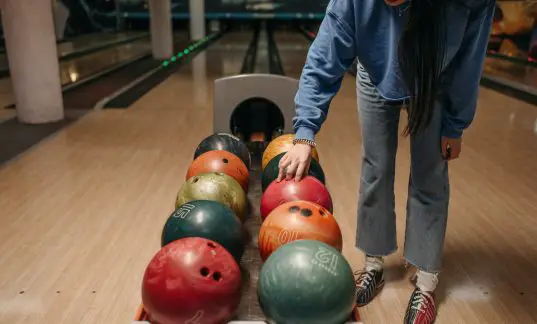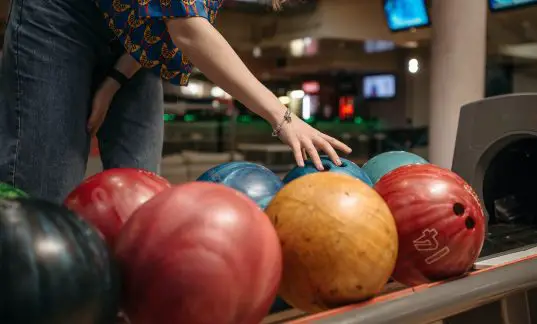Are you tired of throwing the ball straight and watching as your ball rolls ineffectively into the pocket, leaving one or two pins despite seemingly powerful impacts? There is a point where inexperienced bowlers start to see the limitations of straight-shooting.
Maybe it’s when you stop using house balls and start considering buying your own ball. Maybe it’s when most bowlers you’re in league with are ripping off crazy hooks to string bunches of strikes together.
And maybe you’re watching as lane oil kills your straight shots, pushing your ball out of the pocket and your scores down.
If you truly want to become a strike machine in all sorts of lane conditions, achieving consistency with a bowling hook shot is the way to go. A great curve leads to more strikes and higher scores. And more dramatic hooks can lead to increase pin carry and even better scoring averages than that. Better pin carry means better play, and throwing a great hook shot can make that happen.
We’re here to tell you everything that you need to know about hooking a bowling ball — from the wrist support you need to the importance of the handshake position, and everything in between.
What type of bowling ball works best to throw a curve ball?
Your release point and form won’t matter if you don’t have the right bowling ball in hand. A typical plastic bowling ball offers little to no hook potential no matter what lane conditions you’re faced with. A ball with a urethane coverstock offers a bit more hook but tops out at a decent level and nothing more.
If you want to curve a bowling ball effectively and consistently, you’re going to need a reactive resin to tackle today’s increased oil volumes. With the help of fingertip grips and a ball that offers more power and the ability to create revolutions out of nowhere, you can turn a reactive ball’s spin into a real sharp and spectacular hook shot.
Is a hook ball better for getting strikes than a straight ball?
Yes! While some bowlers prefer throwing a straight shot or a softer curve, a good hook ball is usually the final step that a player needs to take to find their game. Small curves are okay too, though, because they open up your entry angles just enough to hit the pin pocket in the perfect spot.
Practice your hooks numerous times in numerous games, over and over and over. Whether you’re on a dry lane, wet lane, or somewhere in between, a really good hook increases your strike possibilities by increasing the violence and creativity of the collisions you can create.
How do you make a ball hook, step by step?
Are you ready to turn your arm swing into a walking bowling weapon? Here’s a step-by-step primer on how to hook a bowling ball:
- Pay attention to your grip and form. You can use a conventional grip to hook a bowling ball, but a fingertip grip or semi-fingertip grip offers more possibilities for hook madness. The depth of your bowling fingers in your ball is inversely proportional to the angularity you can create on the lanes.
- You’re going to use your normal stance with your shoulders facing forward, arms completely straight, and two bowling fingers doing a lot of the work. However, your hand movement and follow-through are going to change up.
- Release the bowling ball at the very bottom of your swing, pulling your thumb out first. You can always keep your thumb out of the ball, cupping it. But, it’s much harder to control your hook ball that way.
- The key to a great hook is to rotate your bowling fingers up the outside of the ball during your release, from 4 o’clock to 7 o’clock (a handshake position). This counter-clockwise rotation and quarter-turn of hand and wrist is crucial. Release the ball by seven o’clock and pay special attention to keeping your swing as powerful as usual.
- To make your curve more pronounced in the middle of your release, work on pulling your fingers out of the ball quicker or adding degrees to your counter-clockwise hand and wrist rotation. Keep your arm straight, your form intact, and practice as much as you can. The more you work on your ball hook, the better you’ll be at it.
Is a lighter ball better to hook than a heavier ball?
While it’s easier to hook a lighter bowling ball due to the laws of physics, it doesn’t mean that it’s better when it comes to results. After all, a heavier ball provides more force when it crushes through the head pin and the nine others that follow. Don’t go light just to add to your hook. Instead, find the right ball weight for you and work hard on your form. Add in some help from customized drill holes and a good reactive resin bowling ball, and you’ll be doing a ton of curve ball damage in no time flat.
7 Tips For Properly Curving Bowling Balls
1) The more severe the curve, the harder it is to control into the pin pocket.
When you first learn how to curve a bowling ball, you might be tempted to hook the ball as hard and sharp as possible. The problem with such a crazy curve is that it’s really hard to tame and direct into the pin pocket. Find a happy medium that leads to the right amount of control and the right level of hook violence.
2) It’s really hard to curve a normal house ball without adjustments.
Most house balls are either plastic coverstock offerings or heavily-used balls with muted reactivity. They are not the optimum equipment for hooking a bowling ball. If you’re getting frustrated with the lack of hook you’re getting with house equipment, try a friend’s ball or buy your own. It’ll help, trust us.
3) Having a hard time completing a hook shot with a conventional grip? Try a fingertip grip!
While you can hook a bowling ball with a conventional second-knuckle ball grip, a first-knuckle fingertip grip adds so much more curve into the equation. It’s harder to control the throw and get it where you want it to go. But, experts love the fingertip grip for opening angles and creating massive back-end reactions.
4) You’re gonna need your own ball to get the dramatic hooks you’re looking for.
Like we said before, think about investing in your own reactive resin strike ball. If you’re trying to improve as a league bowler or a bowler in general, you need good equipment that isn’t worn down or past its prime. You need a bowling ball tailored to your strengths and weaknesses, especially if you want to add some big-time hooks to your throwing arsenal.
5) Mind your arm swing and form past your follow-through at the foul line.
Stay focused during your shot and don’t fly out of your form trying to curve the ball. The better the base, the better the hook. If your footwork or arm swing is off-kilter, your hook will be even more so.
6) Don’t be afraid of playing straight ball — sometimes a straight shot is better.
Once you learn to curve a bowling ball, don’t think that you have to use it for every shot situation. Especially when it comes to single-pin spares, a straight ball is often a better play for the sake of accuracy. Be sure to pay attention to the situation at hand and adjust your shot accordingly.
7) Practice your bowling ball curve with a tennis ball.
Practicing your hook shot at the bowling alley is the best way to get better. But, using a tennis ball at home helps too! Work on throwing the tennis ball with an underhand spiral. If you get it just right, it’ll start straight and then bounce horizontally. This is the motion you need to curve a bowling ball.


